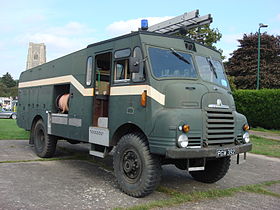Green Goddess
| Bedford RLHZ Self Propelled Pump | |
|---|---|
 |
|
| Overview | |
| Manufacturer | Bedford (General Motors) |
| Also called | Green Goddess |
| Production | 1953–1956 |
| Body and chassis | |
| Class | Commercial vehicle, emergency services vehicle, military vehicle |
| Body style | Fire engine |
| Layout |
Longitudinal front engine, rear-wheel drive (2x4), or four-wheel drive (4x4) |
| Related | Bedford RL |
| Powertrain | |
| Engine | 4.9 L 110 bhp (82 kW) I6 petrol |
| Transmission | 4-speed manual |
The Green Goddess is the colloquial name for the Bedford RLHZ Self Propelled Pump, a fire engine used originally by the Auxiliary Fire Service (AFS), and latterly held in reserve by the Home Office until 2004, and available when required to deal with exceptional events, including being operated by the British Armed Forces during fire-fighters’ strikes (1977 and 2002). These green-painted vehicles were built between 1953 and 1956 for the AFS. The design was based on a Bedford RL series British military truck.
The Auxiliary Fire Service was established as part of civil defence preparations after World War II, and subsequent events such as the Soviet Union detonating an atomic bomb made their presence supporting civilians as part of Britain's civil defence an important role. It was thought that a nuclear attack on Britain would cause a large number of fires, which would overwhelm the ordinary fire service, so a large stock of basic fire engines was ordered to form a reserve capacity. They were in continuous use by the AFS, until disbandment in 1968 by the Harold Wilson Government.
The Green Goddess machines were not primarily fire engines (AFS members referred to them as 'appliances'); they are more correctly titled "self propelled pumps", with some being two-wheel drive (4x2), and others in four-wheel drive (4x4) form. Their main role was to pump huge quantities of water from lakes, rivers, canals and other sources into cities hit by a nuclear attack. The machines could be used in a relay system over a number of miles, with Green Goddesses at regular intervals to boost the water pressure. Firefighting was a secondary role.
...
Wikipedia
